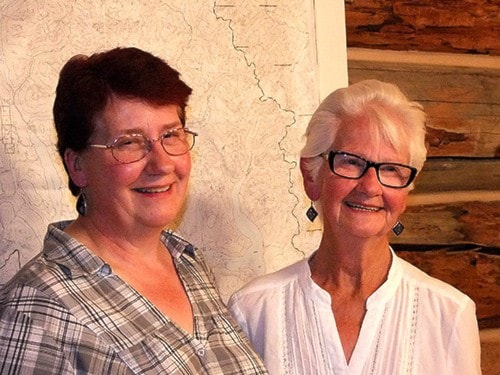The Upper Clearwater is almost unique in that it wasn't that long ago that the first European settlers homesteaded the area.
The first generation is now gone but many of their second generation descendants are still around.
Two of those descendants, Clara Ritcey and Ellen Ferguson, the daughters of Ted and Jennie Helset, recently gave a talk about their memories and knowledge of the early days in the Clearwater River Valley.
About three dozen people turned out to hear them give a detailed presentation on the first homesteaders during a Wells Gray World Heritage event at Upper Clearwater Hall on Friday evening, July 19.
Fage Creek at the south end of Upper Clearwater was named for Alex “Frenchy” Fage, they said, who homesteaded there in 1917.
He was known for talking with himself, and sometimes would have loud political arguments in French and English while he was alone.
“As a child I was fascinated,” said Ritcey.
Fage apparently grew wonderful rhubarb.
Once a passerby, hoping that he would share, told him how good it looked.
Fage, who had already shared some with him and didn't want to do so again, said, “Of course it is good. I pees on it every morning.”
At the end of the presentation Judy Briggs, who lives on a ranch near Fage Creek, said she still has some of that rhubarb in her garden and it still is wonderful – even without the special fertilizer.
Fage did not get along with his neighbor to the north, Herman Ordschig. Eventually he paid $1,800 to buy him out (a small fortune at the time) so he would leave.
Ordschig took the money, then homesteaded the next lot to the north at a cost of $2 (in those years a person could homestead a property by paying a small down payment and then doing a certain amount of improvements each year).
Ordschig had come to the valley in 1913 and made his living by trapping and prospecting. In the fall of 1923 he went out to trap but didn't come back for Christmas. A search party found him in his cabin, dead. Because the ground outside was frozen and covered with snow, they buried him under his cabin – then burned the structure down.
Dave and Gladys Archibald were much beloved “uncle” and “aunt” to many of the valley's children. Gladys Archibald lived to be over 100 and wrote several books of poetry.
Moul Falls is named for Charlie Moul, who came to the valley in the early 1900s. He went away to fight in World War I, and never returned.
Near the parking-lot for the trail to Moul Falls are the remains of the Helsets' goat shed. Their family kept goats when they first arrived in 1938 because the animals needed less land and grass than cows.
Later the Helsets moved further north to Hemp Creek.
Alf and Florence Allison came from Princeton in 1940. They later sold their land to Mac and Cecile MacDiarmid, who started Trophies Lodge there.
The Shook family came from Princeton in 1934. It was a five-day trip, and they needed three trips to carry their belongings from Clearwater to their homestead.
Mrs. Shook was known for feeding every passing stranger. It was just as well there was plenty of game as the family went through a deer every two weeks.
Because they had to wait until the end of school before they left Princeton they had no garden their first year.
However, their neighbors, such as the Ludtkes, stepped in to make sure they had enough fresh produce.
Jack Norman was related to the Archibalds and was lake patrolman and Forestry fire-watchman at Clearwater Lake. He loved to dance and often walked from the lake to take part in a party at Upper Clearwater Hall, then walk back again.
He also loved pumpkin pie.
“I don't think I look at a pumpkin pie without thinking of Jack Norman,” Ritcey said.
The Upper Clearwater Hall was started in 1936 and finished in 1938 by the CCF (Cooperative Commonwealth Federation), the predecessor of the NDP.
Ritcey said their parents came to the first party at the hall but the children were too young and had to stay home.
The nearby 320 acres was homesteaded by Henry Defosses.
He and his neighbor, Lewis Rupell, sheltered in a root house when fire swept through the area in 1926.
The Ludtkes had the property to the north and lost everything in the fire. The family only survived by hiding in a creek.
The Ludtkes had come to the valley by horse and wagon from North Dakota. The 2,000 mile trip took them two months.
Look for more about Clara Ritcey's and Ellen Ferguson's talk in a future issue of the Times.
